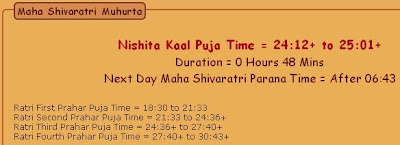Sunday, 10th March, 2013.
The normal ritual involved in observing Shivaratri are as follows:
1)Should fast the whole day without even drinking water.
2)Should perform at least Eka Rudra Abhishekam to Lord Shiva in the night to Lord Shiva, offering of Bilva Patra orBel leaves is considered to give high returns.
3)Offer fruits as Naivedyam or offering and eat only those for the night.
4)Should be awake the whole night enchanting the name of Lord Shiva
5)If possible do Abhishekam to Lord Shiva during Lingodbhava Kalam that is exactly at 00:48 hrs.
6)Should sleep only on the night of next day.
1)Should fast the whole day without even drinking water.
2)Should perform at least Eka Rudra Abhishekam to Lord Shiva in the night to Lord Shiva, offering of Bilva Patra orBel leaves is considered to give high returns.
3)Offer fruits as Naivedyam or offering and eat only those for the night.
4)Should be awake the whole night enchanting the name of Lord Shiva
5)If possible do Abhishekam to Lord Shiva during Lingodbhava Kalam that is exactly at 00:48 hrs.
6)Should sleep only on the night of next day.

Vrat Vidhi – One day before Shivaratri Vratam,
most likely on Trayodashi, devotees should eat only one time. On
Shivaratri day, after finishing morning rituals devotees should take Sankalp (संकल्प) to observer full day fast on Shivaratri and to take food next day. During Sankalp devotees pledge for self-determination throughout the fasting period and seek blessing of Lord Shiva
to finish the fast without any interference. Hindu fasts are strict and
people pledge for self-determination and seek God blessing before
starting them to finish them successfully.


